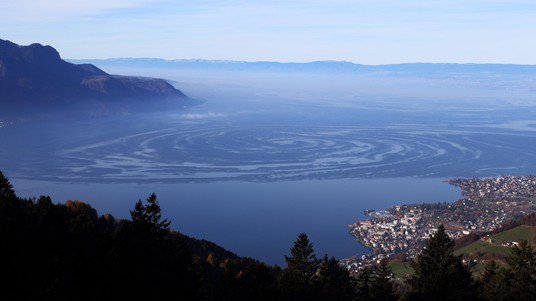Warm enough? Lake Geneva forecasts now online

© 2016 EPFL – Alain Herzog
A new web service provides real-time information and forecasts of water temperature and surface water currents. First and foremost a tool for scientists, the map could help you find just the right beach for your next swim.
If you have spent time on the beaches around Lake Geneva, you may already have noticed that some spots are warmer than others, and that the wind somehow plays into the equation. So which beach should you choose for your next swim? meteolakes.epfl.ch, an online platform with real-time 3D simulations of Lake Geneva, provides water temperature and current forecasts for the entire lake. The platform, which is open to the public, was initially developed to validate environmental data gathered by orbiting satellites. Beyond that, it contributes to a deeper understanding of the dynamic processes playing out in the lake, with new insights into phenomena that conventional monitoring techniques are unable to observe.
For Theo Baracchini, the PhD student in the Physics of Aquatic Systems laboratory who created the platform, monitoring a lake’s entire volume is more essential today than ever before. “I think of lakes as sentinels of climate change. They contain a tremendous diversity of ecosystems, some which are likely to be among the first visible victims of a changing climate. But to pick up on this, we have to monitor them as a whole. The current approach, which involves sampling a lake at a single location once or twice a month at best is simply not enough anymore,” he says.
New avenues for lake science
The online platform lets viewers travel through time and follow the evolution of the lake temperature and surface water currents throughout the year. But the model driving the simulation does far more than that. “The challenge was to integrate different types of data into a single framework: classical point measurements, data sensed remotely from satellites, and data generated using computer simulations. Combining these three sources of data will allow us to provide a reliable and flexible global modeling framework for lakes in various regions of the world, starting with Lake Geneva as showcase for the technology,” he explains.
“Our simulation opens new avenues for studying 3D structures and meso-scale processes in lakes, that is, processes that play out over large portions of the lake and have often been neglected. For example, by simulating the interaction of the wind, using data provided by MeteoSuisse weather forecasts, with the water body, we capture phenomena such as upwelling, whereby fresh water from the depths of the lake is brought up to the surface,” says Baracchini.
Two tabs let users see transects of lake water temperature from the surface all the way down to the lakebed. “Once or twice a year, typically in spring and autumn, the thermocline – the line that separates warmer surface water from the cold deep water below – disappears and the lake water mixes. This process is essential for the lake ecosystem health,” says Baracchini.
A wealth of applications
Baracchini’s platform is the central component of CORESIM, a European Space Agency project that is funding his work. Initially destined to validate lake temperature and chlorophyll measurements made using the agency’s satellite-borne high-resolution sensing devices, the data it produces has a wealth of other applications. Fishermen could benefit from the platform to locate pronounced temperature gradients, an indicator of rich fishing grounds. Engineers could use it to design heating and cooling systems that utilize lake water. And environmental engineers could use it to predict the spread and dilution of pollutant plumes.
For Baracchini, modeling water temperature and surface currents of Lake Geneva is only a first step. In the future, he plans to simulate other factors, such as algae and oxygen concentrations and to apply his model to other Swiss lakes. And as a researcher who grew up next to Lake Geneva, keeping the platform open to the public is essential. “I am happy to provide an open, practical, and local application of our research to a broad audience,” he concludes.
For a first look at the new platform, go to meteolakes.epfl.ch, and stay tuned for a more in depth view into the physics of Lake Geneva.


